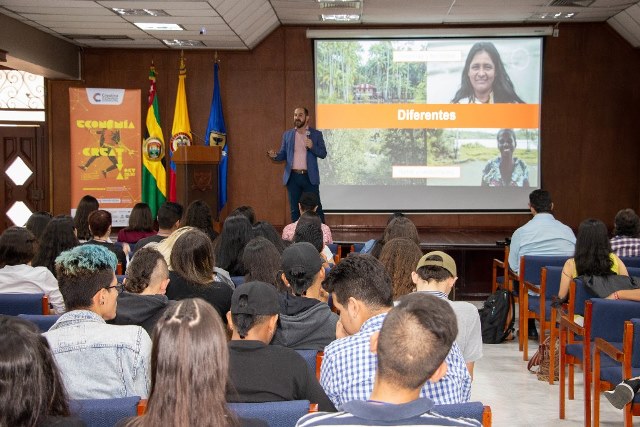LA UDES PUBLICA
- Fecha de publicación:
- 2024-09-01
- Tipo:
- Article
- Número de artículo:
- e2684
- Identificación:
- SCOPUS_ID:85205550377
- eID:
- 2-s2.0-85205550377
- Nombre de la revista:
- Revista Colombiana de Antropologia
- Autor(es) UDES:
- García M.P.L.
- Autor Principal:
- García M.P.L.
- Áreas del conocimiento:
- Cultural Studies, Archeology (arts and humanities), Anthropology, History
Cuartil
Q1
- Ranking
- 15745
- Tipo
- Journal
- ISSN
- 04866525
- eISSN
- 2539472X
- Región
- Latin America
- País
- Colombia
- Volumen
- 60
- Cobertura
- 2011-2022
- Fecha de publicación:
- 2024-09-01
- Tipo:
- Editorial
- Identificación:
- SCOPUS_ID:85204181851
- eID:
- 2-s2.0-85204181851
- Nombre de la revista:
- Bacteria
- Autor(es) UDES:
- Guerra-Sierra B.E.
- Otros Autores:
- Mitra D., Pellegrini M.
- Autor Principal:
- Mitra D.
- Áreas del conocimiento:
- Agricultural and Biological Sciences (miscellaneous), Biochemistry, Genetics and Molecular Biology (miscellaneous), Immunology and Microbiology (miscellaneous)
- Tipo
- Journal
- eISSN
- 26741334
- Volumen
- 3
- Rango de páginas
- 136-140
- Fecha de publicación:
- 2024-09-01
- Tipo:
- Article
- Número de artículo:
- 093
- Identificación:
- SCOPUS_ID:85201702280
- eID:
- 2-s2.0-85201702280
- Nombre de la revista:
- Tropical and Subtropical Agroecosystems
- Autor(es) UDES:
- Núñez-Rodríguez J.d.J.
- Otros Autores:
- Zuniga-González C.A.
- Autor Principal:
- Núñez-Rodríguez J.d.J.
- Áreas del conocimiento:
- Ecology, Evolution, Behavior and Systematics, Ecology, Agricultural and Biological Sciences (miscellaneous)
Cuartil
Q3
- Ranking
- 19101
- Tipo
- Journal
- eISSN
- 18700462
- Región
- Latin America
- País
- Mexico
- Volumen
- 27
- Cobertura
- 2011-2022
- Fecha de publicación:
- 2024-09-01
- Tipo:
- Article
- Número de artículo:
- 142995
- Identificación:
- SCOPUS_ID:85200919476
- eID:
- 2-s2.0-85200919476
- Nombre de la revista:
- Chemosphere
- Autor(es) UDES:
- Amaya Á.A.
- Otros Autores:
- Martínez Q H., Neira J.A., Blach V D., Campos C.H., Martínez O F.
- Autor Principal:
- Martínez Q H.
- Áreas del conocimiento:
- Environmental Engineering, Environmental Chemistry, Chemistry (all), Pollution, Public Health, Environmental and Occupational Health, Health, Toxicology and Mutagenesis
Cuartil
Q1
- Ranking
- 1677
- Tipo
- Journal
- ISSN
- 00456535
- eISSN
- 18791298
- Región
- Western Europe
- País
- United Kingdom
- Volumen
- 364
- Cobertura
- 1972-2022
- Fecha de publicación:
- 2024-09-01
- Tipo:
- Article
- Número de artículo:
- 100312
- Identificación:
- SCOPUS_ID:85186504275
- eID:
- 2-s2.0-85186504275
- Nombre de la revista:
- Emerging Contaminants
- Autor(es) UDES:
- Joya-Cárdenas D.R.
- Otros Autores:
- Rodríguez-Caicedo J.P., Corona-Rivera M.A., Saldaña-Robles N., Damián-Ascencio C.E., Saldaña-Robles A.
- Autor Principal:
- Joya-Cárdenas D.R.
- Áreas del conocimiento:
- Toxicology, Public Health, Environmental and Occupational Health, Health, Toxicology and Mutagenesis
Cuartil
Q1
- Ranking
- 2186
- Tipo
- Journal
- ISSN
- 24056650
- eISSN
- 24056642
- Región
- Asiatic Region
- País
- China
- Volumen
- 10
- Cobertura
- 2015-2022
- Fecha de publicación:
- 2024-09-01
- Tipo:
- Article
- Identificación:
- SCOPUS_ID:85185133648
- eID:
- 2-s2.0-85185133648
- Nombre de la revista:
- Sport Sciences for Health
- Autor(es) UDES:
- Cohen D.D.
- Otros Autores:
- Spyrou K., Alcaraz P.E., Marín-Cascales E., Freitas T.T.
- Autor Principal:
- Spyrou K.
- Áreas del conocimiento:
- Orthopedics and Sports Medicine
Cuartil
Q3
- Ranking
- 12541
- Tipo
- Journal
- ISSN
- 18247490
- eISSN
- 18251234
- Región
- Western Europe
- País
- Italy
- Volumen
- 20
- Rango de páginas
- 837-842
- Cobertura
- 2004-2022
- Fecha de publicación:
- 2024-08-31
- Tipo:
- Article
- Identificación:
- SCOPUS_ID:85202151977
- eID:
- 2-s2.0-85202151977
- Nombre de la revista:
- The Lancet
- Otros Autores:
- Zhou B., Bennett J.E., Wickham A.P., Singleton R.K., Mishra A., Carrillo-Larco R.M., Ikeda N., Jain L., Barradas-Pires A., Heap R.A., Lhoste V.P.F., Sheffer K.E., Phelps N.H., Rayner A.W., Gregg E.W., Woodward M., Stevens G.A., Iurilli M.L.C., Danaei G., Cesare M.D., Aguilar-Salinas C.A., Ahmad N.A., Bovet P., Chen Z., Damasceno A., Filippi S.L., Janszky I., Kengne A.P., Khang Y.H., Khunti K., Laxmaiah A., Lim L.L., Lissner L., Margozzini P., Mbanya J.C., McGarvey S., Shaw J.E., Söderberg S., Soto-Mota L.A., Wang J., Zaccardi F., Ezzati M., Abarca-Gómez L., AbbasiKangevari M., Abdrakhmanova S., Abdul Ghaffar S.A., Abdul Rahim H.F., Abdurrahmonova Z., Abu-Rmeileh N.M., Acosta-Cazares B., Adam I., Adamczyk M., Aekplakorn W., Agdeppa I.A., Aghazadeh-Attari J., Agyemang C., Ahmad M.H., Ahmadi A., Ahmadi N., Ahmadi N., Ahmed S.H., Ahrens W., Aitmurzaeva G., Ajlouni K., Al-Hazzaa H.M., Al-Hinai H., Al-Lawati J.A., Al-Raddadi R., Asfoor D.A., Al Hourani H.M., Alarouj M., AlBuhairan F., AlDhukair S., Ali M.M., Alieva A.V., Alkandari A., Alkhatib B.M., Aly E., Amarapurkar D.N., Amiano Etxezarreta P., Amougou N., Andersen L.B., Anderssen S.A., Androutsos O., Anjana R.M., Ansari-Moghaddam A., Anufrieva E., Aounallah-Skhiri H., Aris T., Arku R.E., Arlappa N., Aryal K.K., Assah F.K., Assembekov B., Assunção M.C.F., Auvinen J., Avdicová M., Azad K., Azevedo A., Azimi-Nezhad M.
- Autor Principal:
- Zhou B.
- Áreas del conocimiento:
- Medicine (all)
Cuartil
Q1
- Ranking
- 31
- Tipo
- Journal
- ISSN
- 01406736
- eISSN
- 1474547X
- Región
- Western Europe
- País
- United Kingdom
- Volumen
- 404
- Rango de páginas
- 851-863
- Cobertura
- 1823-2022
- Fecha de publicación:
- 2024-08-19
- Tipo:
- Article
- Número de artículo:
- e015120
- Identificación:
- SCOPUS_ID:85206291937
- eID:
- 2-s2.0-85206291937
- Nombre de la revista:
- BMJ Global Health
- Autor(es) UDES:
- Lopez-Jaramillo P.
- Otros Autores:
- Vidyasagaran A.L., Ayesha R., Boehnke J.R., Kirkham J., Rose L., Hurst J.R., Miranda J.J., Rana R.Z., Vedanthan R., Faisal M.R., Afaq S., Agarwal G., Aguilar-Salinas C.A., Akinroye K., Akinyemi R.O., Ali S.R., Aman R., Anza-Ramirez C., Appuhamy K.K., Baldew S.S., Barbui C., Batista S.R.R., Caamaño M.D.C., Chowdhury A.H., De Siqueira-Filha N.T., Del Castillo Fernández D., Downey L., Flores-Flores O., García O.P., García-Ulloa A.C., Holt R.I.G., Huque R., Kabukye J.K., Kanan S., Khalid H., Koly K.N., Kwashie J.S., Levitt N.S., Mohan S., Muliyala K.P., Naz Q., Odili A.N., Oyeyemi A.L., Pacheco-Barrios N.V., Praveen D., Purgato M., Ronquillo D., Siddiqi K., Singh R., Tran P.B., Tufail P., Uphoff E.P., Van Olmen J., Verhey R., Wright J.M., Zafra-Tanaka J.H., Zavala G.A., Zhao Y.W., Siddiqi N.
- Autor Principal:
- Vidyasagaran A.L.
- Áreas del conocimiento:
- Health Policy, Public Health, Environmental and Occupational Health
Cuartil
Q1
- Ranking
- 982
- Tipo
- Journal
- eISSN
- 20597908
- Región
- Western Europe
- País
- United Kingdom
- Volumen
- 9
- Cobertura
- 2016-2022
- Fecha de publicación:
- 2024-08-15
- Tipo:
- Article
- Número de artículo:
- e35739
- Identificación:
- SCOPUS_ID:85200536724
- eID:
- 2-s2.0-85200536724
- Nombre de la revista:
- Heliyon
- Autor(es) UDES:
- Bellon Monsalve D., Martínez-Amariz A.D.
- Otros Autores:
- Ulate-Kolitsky E., Huot J.
- Autor Principal:
- Bellon Monsalve D.
- Áreas del conocimiento:
- Multidisciplinary
Cuartil
Q1
- Ranking
- 8422
- Tipo
- Journal
- eISSN
- 24058440
- Región
- Western Europe
- País
- Netherlands
- Volumen
- 10
- Cobertura
- 2015-2022
- Fecha de publicación:
- 2024-08-15
- Tipo:
- Article
- Número de artículo:
- e35286
- Identificación:
- SCOPUS_ID:85199796780
- eID:
- 2-s2.0-85199796780
- Nombre de la revista:
- Heliyon
- Autor(es) UDES:
- Luna-Guevara F.
- Otros Autores:
- San juan-Garisado Y., Herrera P.A., Soto-Paz J., Alvarez-Trujillo J.D., Mejia-Parada C., Parra-Orobio B.A.
- Autor Principal:
- San juan-Garisado Y.
- Áreas del conocimiento:
- Multidisciplinary
Cuartil
Q1
- Ranking
- 8422
- Tipo
- Journal
- ISSN
- 24058440
- Región
- Western Europe
- País
- Netherlands
- Volumen
- 10
- Cobertura
- 2015-2022
- Fecha de publicación:
- 2024-08-15
- Tipo:
- Article
- Número de artículo:
- 114358
- Identificación:
- SCOPUS_ID:85197259409
- eID:
- 2-s2.0-85197259409
- Nombre de la revista:
- Molecular Catalysis
- Autor(es) UDES:
- Amaya Á.A.
- Otros Autores:
- Martínez H., Páez-Mozo E., O F.M.
- Autor Principal:
- Martínez H.
- Áreas del conocimiento:
- Catalysis, Process Chemistry and Technology, Physical and Theoretical Chemistry
Cuartil
Q2
- Ranking
- 6399
- Tipo
- Journal
- ISSN
- 24688231
- Región
- Western Europe
- País
- Netherlands
- Volumen
- 565
- Cobertura
- 2017-2022
- Fecha de publicación:
- 2024-08-10
- Tipo:
- Article
- Identificación:
- SCOPUS_ID:85200583202
- eID:
- 2-s2.0-85200583202
- Nombre de la revista:
- The Lancet
- Autor(es) UDES:
- Lopez-Jaramillo P.
- Otros Autores:
- Joundi R.A., Hu B., Rangarajan S., Leong D.P., Islam S., Smith E.E., Mirrakhimov E., Seron P., Alhabib K.F., Assembekov B., Chifamba J., Yusuf R., Khatib R., Felix C., Yusufali A., Mohammadifard N., Rosengren A., Oguz A., Iqbal R., Yeates K., Avezum A., Kruger I., Anjana R., PVM L., Gupta R., Zatońska K., Barbarash O., Pelliza E., Rammohan K., Li M., Li X., Ismail R., Evans M., O\'Donnell M., Yusuf S.
- Autor Principal:
- Joundi R.A.
- Áreas del conocimiento:
- Medicine (all)
Cuartil
Q1
- Ranking
- 31
- Tipo
- Journal
- ISSN
- 01406736
- eISSN
- 1474547X
- Región
- Western Europe
- País
- United Kingdom
- Volumen
- 404
- Rango de páginas
- 554-569
- Cobertura
- 1823-2022
- Fecha de publicación:
- 2024-08-01
- Tipo:
- Article
- Número de artículo:
- 8920
- Identificación:
- SCOPUS_ID:85202619608
- eID:
- 2-s2.0-85202619608
- Nombre de la revista:
- International Journal of Molecular Sciences
- Autor(es) UDES:
- Quintero-García W.L., Espinel-Mesa D.X., Moreno E.M., García L.T.
- Otros Autores:
- Stashenko E., Mesa-Arango A.C.
- Autor Principal:
- Quintero-García W.L.
- Áreas del conocimiento:
- Catalysis, Molecular Biology, Spectroscopy, Computer Science Applications, Physical and Theoretical Chemistry, Organic Chemistry, Inorganic Chemistry
- Tipo
- Journal
- ISSN
- 16616596
- eISSN
- 14220067
- Volumen
- 25
- Fecha de publicación:
- 2024-08-01
- Tipo:
- Article
- Número de artículo:
- 923
- Identificación:
- SCOPUS_ID:85202568552
- eID:
- 2-s2.0-85202568552
- Nombre de la revista:
- Biomolecules
- Autor(es) UDES:
- Rondón-Villarreal P.
- Otros Autores:
- Rodríguez-Sarmiento D.Y., Scarpelli-Pereira P.H., Bouvier M.
- Autor Principal:
- Rodríguez-Sarmiento D.Y.
- Áreas del conocimiento:
- Biochemistry, Molecular Biology
Cuartil
Q1
- Ranking
- 3733
- Tipo
- Journal
- eISSN
- 2218273X
- Región
- Western Europe
- País
- Switzerland
- Volumen
- 14
- Cobertura
- 2011-2022
- Fecha de publicación:
- 2024-08-01
- Tipo:
- Article
- Número de artículo:
- 81
- Identificación:
- SCOPUS_ID:85202462735
- eID:
- 2-s2.0-85202462735
- Nombre de la revista:
- ChemEngineering
- Autor(es) UDES:
- Bellon Monsalve D., Martínez-Amariz A.D.
- Otros Autores:
- Ulate-Kolitsky E., Cubero-Sesin J.M., Huot J.
- Autor Principal:
- Bellon Monsalve D.
- Áreas del conocimiento:
- Chemical Engineering (all), Engineering (all), Energy (all)
Cuartil
Q2
- Ranking
- 10873
- Tipo
- Journal
- eISSN
- 23057084
- Región
- Western Europe
- País
- Switzerland
- Volumen
- 8
- Cobertura
- 2017-2022
- Fecha de publicación:
- 2024-08-01
- Tipo:
- Article
- Identificación:
- SCOPUS_ID:85198537764
- eID:
- 2-s2.0-85198537764
- Nombre de la revista:
- Obesity Surgery
- Autor(es) UDES:
- Álvarez Leon D., Barrera Arguello D.M.
- Otros Autores:
- Domínguez Alvarado G.A., López Gómez L.E., Serrano Baez G.A., Serrano Gómez S.E., Vásquez Pineda A., Bustos Lopez T., Arévalo González M.A., Palomino Peña C.F., Chavarría Granda L.D.
- Autor Principal:
- Domínguez Alvarado G.A.
- Áreas del conocimiento:
- Surgery, Endocrinology, Diabetes and Metabolism, Nutrition and Dietetics
Cuartil
Q1
- Ranking
- 3447
- Tipo
- Journal
- ISSN
- 09608923
- eISSN
- 17080428
- Región
- Northern America
- País
- United States
- Volumen
- 34
- Rango de páginas
- 2897-2906
- Cobertura
- 1991-2022
- Fecha de publicación:
- 2024-08-01
- Tipo:
- Article
- Número de artículo:
- zrae056
- Identificación:
- SCOPUS_ID:85198463144
- eID:
- 2-s2.0-85198463144
- Nombre de la revista:
- BJS Open
- Autor(es) UDES:
- Gaona J.
- Otros Autores:
- Sotelo R., Sayegh A.S., Medina L.G., Perez L.C., Riva A.L., Eppler M.B., Tobias-Machado M., Spiess P.E., Pettaway C.A., Pompeo A.C.L., Mattos P.A.L., Wilson T.G., Villoldo G.M., Chung E., Samaniego A., Ornellas A.A., Pinheiro V., Brazão E.S., Subira-Rios D., Koifman L., de Cassio Zequi S., Pontillo H.M., de Ribamar Rodrigues Calixto J., Silva R.C., Mark Smithers B., Garzon S., Haase O., Sommariva A., Fruscio R., Martins F., de Oliveira P.S., Sandri G.B.L., Clementi M., Astigueta J., Metwally I.H., Bharathan R., Jindal T., Nakamura Y., Mageed H.A., Jeevarajan S., Lay R.R., García-Perdomo H.A., González O.R., Ghodoussipour S., Gill I., Cacciamani G.E.
- Autor Principal:
- Sotelo R.
- Áreas del conocimiento:
- Surgery
Cuartil
Q1
- Ranking
- 3318
- Tipo
- Journal
- eISSN
- 24749842
- Región
- Western Europe
- País
- United Kingdom
- Volumen
- 8
- Cobertura
- 2017-2022
- Fecha de publicación:
- 2024-08-01
- Tipo:
- Article
- Número de artículo:
- 101076
- Identificación:
- SCOPUS_ID:85197249592
- eID:
- 2-s2.0-85197249592
- Nombre de la revista:
- Veterinary Parasitology: Regional Studies and Reports
- Autor(es) UDES:
- Pinilla J.C.
- Otros Autores:
- Pinilla A.I.
- Autor Principal:
- Pinilla J.C.
- Áreas del conocimiento:
- Parasitology, Veterinary (all)
Cuartil
Q2
- Ranking
- 11345
- Tipo
- Journal
- eISSN
- 24059390
- Región
- Western Europe
- País
- Netherlands
- Volumen
- 53
- Cobertura
- 2015-2022
- Fecha de publicación:
- 2024-08-01
- Tipo:
- Article
- Número de artículo:
- 105177
- Identificación:
- SCOPUS_ID:85195216846
- eID:
- 2-s2.0-85195216846
- Nombre de la revista:
- Journal of Structural Geology
- Autor(es) UDES:
- Amaya S.
- Otros Autores:
- Villamizar-Escalante N., Zuluaga C.A., Bernet M., López-Isaza J.A., García-Delgado H., Velandia F.
- Autor Principal:
- Villamizar-Escalante N.
- Áreas del conocimiento:
- Geology
Cuartil
Q1
- Ranking
- 2981
- Tipo
- Journal
- ISSN
- 01918141
- Región
- Western Europe
- País
- United Kingdom
- Volumen
- 185
- Cobertura
- 1979-2022
- Fecha de publicación:
- 2024-08-01
- Tipo:
- Review
- Identificación:
- SCOPUS_ID:85190939383
- eID:
- 2-s2.0-85190939383
- Nombre de la revista:
- European Journal of Internal Medicine
- Autor(es) UDES:
- López-López J.P.
- Otros Autores:
- Coca A., Whelton S.P., Camafort M., Yang E.
- Autor Principal:
- Coca A.
- Áreas del conocimiento:
- Internal Medicine
Cuartil
Q2
- Ranking
- 4250
- Tipo
- Journal
- ISSN
- 09536205
- eISSN
- 18790828
- Región
- Western Europe
- País
- Netherlands
- Volumen
- 126
- Rango de páginas
- 16-25
- Cobertura
- 1989-2022
- Fecha de publicación:
- 2024-08-01
- Tipo:
- Article
- Identificación:
- SCOPUS_ID:85189989985
- eID:
- 2-s2.0-85189989985
- Nombre de la revista:
- Veterinary Research Communications
- Autor(es) UDES:
- Sandoval-Ramírez C.M., Pinilla J.C.
- Otros Autores:
- Ballesteros N., Hernández C., Muñoz M., Ramírez J.D.
- Autor Principal:
- Sandoval-Ramírez C.M.
- Áreas del conocimiento:
- Veterinary (all)
- Tipo
- Journal
- ISSN
- 01657380
- eISSN
- 15737446
- Volumen
- 48
- Rango de páginas
- 2657-2662
- Fecha de publicación:
- 2024-07-12
- Tipo:
- Article
- Número de artículo:
- e3550
- Identificación:
- SCOPUS_ID:85199872630
- eID:
- 2-s2.0-85199872630
- Nombre de la revista:
- Innovaciencia
- Autor(es) UDES:
- Gómez Jaimes F.N.
- Otros Autores:
- Muñoz Ríos S.J., Rey Hernández L.M., Acuña Rodríguez K.N., Acuña Llanes Á.C.
- Autor Principal:
- Muñoz Ríos S.J.
- Áreas del conocimiento:
- Agricultural and Biological Sciences (miscellaneous), Chemistry (miscellaneous)
- Tipo
- Journal
- eISSN
- 2346075X
- Volumen
- 12
- Fecha de publicación:
- 2024-07-01
- Tipo:
- Article
- Número de artículo:
- 3906
- Identificación:
- SCOPUS_ID:85198435187
- eID:
- 2-s2.0-85198435187
- Nombre de la revista:
- Journal of Clinical Medicine
- Autor(es) UDES:
- Martínez-Vega R.A.
- Otros Autores:
- Becerra-Mojica C.H., Parra-Saavedra M.A., Díaz-Martínez L.A., Martínez-Portilla R.J., Torres-Torres J., Rincon-Orozco B.
- Autor Principal:
- Becerra-Mojica C.H.
- Áreas del conocimiento:
- Medicine (all)
Cuartil
Q1
- Ranking
- 4693
- Tipo
- Journal
- eISSN
- 20770383
- Región
- Western Europe
- País
- Switzerland
- Volumen
- 13
- Cobertura
- 2013-2022
- Fecha de publicación:
- 2024-07-01
- Tipo:
- Article
- Identificación:
- SCOPUS_ID:85198022929
- eID:
- 2-s2.0-85198022929
- Nombre de la revista:
- Microbiology Spectrum
- Autor(es) UDES:
- Guerra Sierra B.E.
- Otros Autores:
- Jaramillo-Mazo C., Bravo D., Alvarez J.C.
- Autor Principal:
- Jaramillo-Mazo C.
- Áreas del conocimiento:
- Physiology, Ecology, Immunology and Microbiology (all), Genetics, Microbiology (medical), Cell Biology, Infectious Diseases
Cuartil
Q1
- Ranking
- 3627
- Tipo
- Journal
- eISSN
- 21650497
- Región
- Northern America
- País
- United States
- Volumen
- 12
- Cobertura
- 2013-2022
- Fecha de publicación:
- 2024-07-01
- Tipo:
- Article
- Identificación:
- SCOPUS_ID:85196099114
- eID:
- 2-s2.0-85196099114
- Nombre de la revista:
- Medicine and Science in Sports and Exercise
- Autor(es) UDES:
- O’Donovan G., Martínez D., López-López J.P., Otero J., Campo M.C., Perez-Mayorga M., López-Jaramillo P.
- Otros Autores:
- Urina M., Vasquez T., Niño M., Narvaez C., Rodríguez S., Arcos E., Sanchez G., García H., Rangarajan S., Yusuf S.
- Autor Principal:
- O’Donovan G.
- Áreas del conocimiento:
- Orthopedics and Sports Medicine, Physical Therapy, Sports Therapy and Rehabilitation
- Tipo
- Journal
- ISSN
- 01959131
- eISSN
- 15300315
- Volumen
- 56
- Rango de páginas
- 1291-1296
Bogotá
Cra. 14 N° 80-35
PBX: (+57) (601) 6914004
Línea Directa Interesados Programas: (601) 6914104
Horario de Atención: lunes a viernes de 7:00 a.m - 12:00 m. y de 2:00 p.m a 6:00 p.m
Pregrados
Universidad de Santander UDES. Vigilada Mineducación.
Resolución otorgada por el Ministerio de Educación Nacional: No. 6216 del 22 de diciembre de 2005 / Personería Jurídica 810 de 12/03/96.
Institución sujeta a inspección y vigilancia por el Ministerio de Educación Nacional. Resolución 12220 de 2016.
Notificaciones administrativas y judiciales:
Copyright © 2021 - Todos los derechos reservados



























